vsmPanel - Operation
Starting vsmPanel
After vsmPanel has been installed, the application can be started through the windows start function (Virtual Studio Manager > vsmPanel). Initially started the Host entry is empty and Panel ID has the value '0' entered. Furthermore you can decide either opening the vsmPanel directly or the vsmPanel Configuration Mode.

Selecting vsmPanel will automatically open the control panel of the currently set panel ID. Alternatively, a desktop shortcut can be created, or the vsmPanel icon can be placed in the Windows taskbar from where the program can be started.
vsmPanel Configuration Mode
Using vsmPanel (Configuration Mode) will open the vsmPanel configuration window where you can change settings regarding the virtual panel.
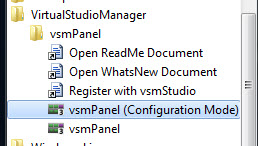
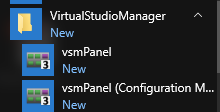
You can create a configuration mode .exe by creating a shortcut of vsmPanel.exe and adding '-config' at the end of the Target string within the shortcut properties.

Connection
The currently connected host can be entered under Connection in the window vsmPanel (Configuration Mode).
When entering 'localhost' as the host vsmPanel runs in Single Server Mode.
![]()

When naming a virtual Panel 'User: *' in vsmStudio every panel user that will connect to this server will be connected to this ID independent of the ID in the vsmPanel configuration mode.
![]()
View
Under the View tab, different views can be chosen:
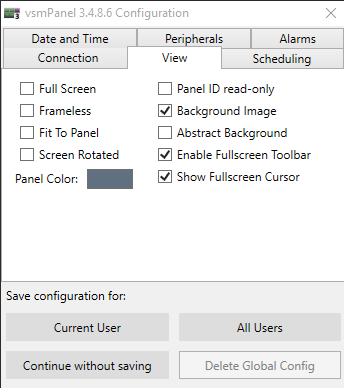
Full Screen
'Full Screen' checked will display vsmPanel in full screen mode.

It is possible to close vsmPanel by selecting the white cross in the Fullscreen Toolbar or by pressing Alt+F4.
![]()
Frameless
'Frameless' checked will display vsmPanel without any borders.
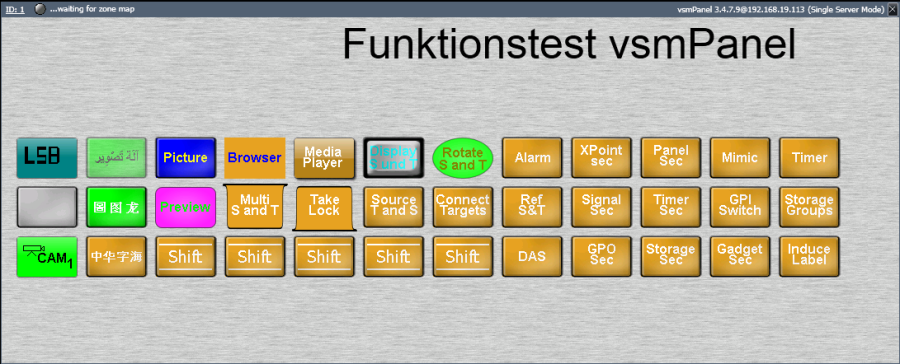
Fit To Panel
Once checked the window borders of vsmPanel will adjust to the size of the virtual Panel when opening vsmPanel. Afterwards you can change the size of the window.
Screen Rotated
'Screen rotated' turn the virtual Panel upside down.
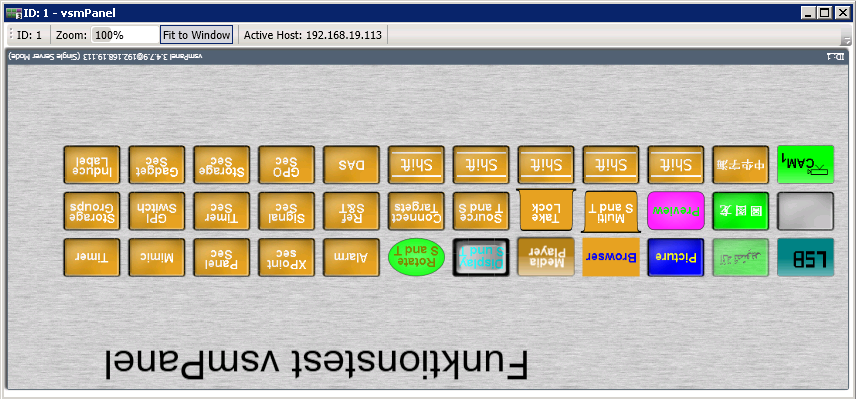
Enable Fullscreen Toolbar
'Enable Fullscreen Toolbar' activates the toolbar in fullscreen mode which pops up when crossing the top border of the screen. When unchecked the toolbar is no longer available.
Panel ID read-only
It is possible to change the Panel ID within the vsmPanel window. For this reason press onto the ID section which opens the Panel Number window where you can enter another Panel ID.

When 'Panel ID read-only' is checked this function is turned off and you are just able to observe the Panel ID.
Background Image
'Background Image' checked will place a default background onto the virtual Panel.


Abstract Background
This is the same for 'Abstract Background'

Panel Color
'Panel color' allows you to choose a background color for the virtual panel when no default background is used. The background color combined with a default background image shows the following effect:
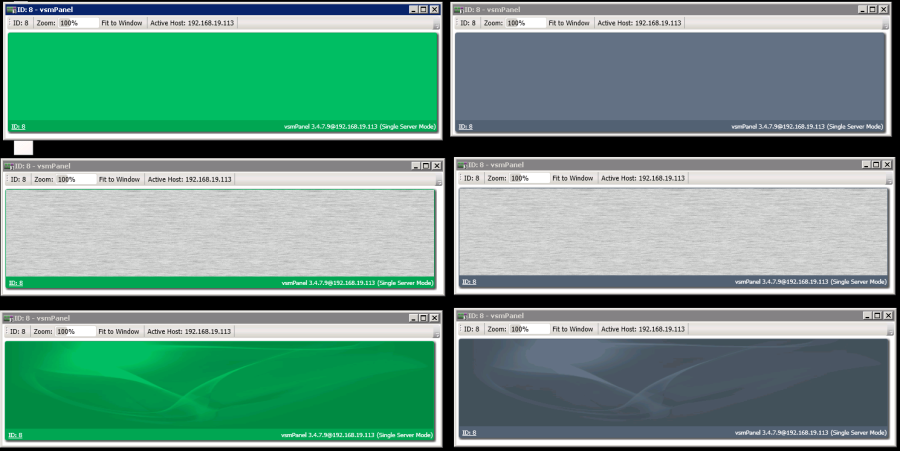
Scheduling
The settings of the scheduler bar can be changed under Scheduling.
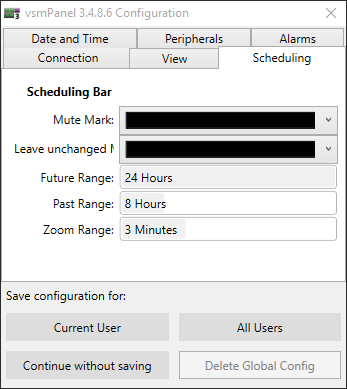
Mute Mark
Here you can choose the color of the Mute Mark that will be displayed within a scheduler event when configured. It can be configured either at the end of an event or the Release of the event.
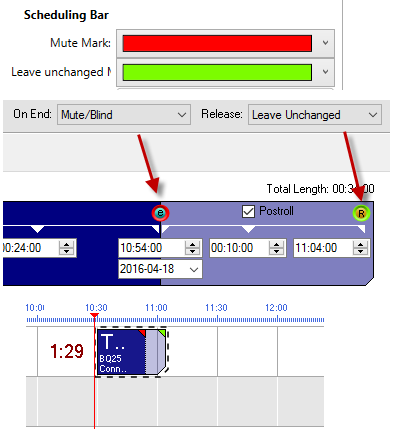
Leave unchanged Mark
Here you can choose the color of the Leave Unchanged Mark that will be displayed within a scheduler event when configured. It can be configured either at the end of an event or the Release of the event.

Future Range
Here you can choose the amount of time you can scroll into the future. (Range 4-24 hours)
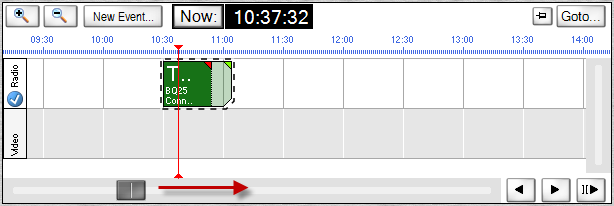
Past Range
Here you can choose the amount of time you can scroll into the past. (Range 4-24 hours)

Date and Time

Within the Date and Time tab you can change the format of the displayed Date and Time. The format changes will be displayed in the Scheduler page and clock item.
Peripherals
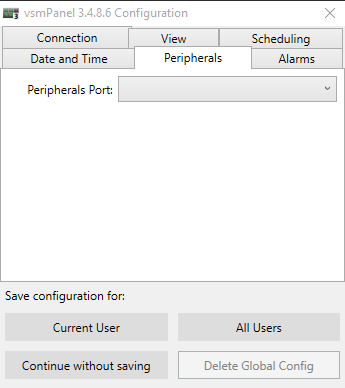
Additional ports can be selected under the Peripherals tab.
Alarms
'Delete reports after 24 hours' will delete the reports within the Alarm Management page item after 24 hours.

Save configuration for:
When upgrading vsmPanel to 3.4.8.6 or higher, the registry keys containing the following vsmPanel settings will be deleted:
HKEY_CURRENT_USER\Software\VirtualStudioManager\vsmPanel\Settings.3
HKEY_LOCAL_MACHINE\Software\VirtualStudioManager\vsmPanel\Settings.3
This action does not depend on admin rights.
If there is a Global configuration file (.xml) under D:\VSM\vsmPanel it will be deleted after installing and opening vsmPanel 3.4.8.6 or higher with or without admin rights. The content of the xml file will be saved under C:\ProgramData\Lawo\vsmPanel as a new Global configuration file.
If there is no Global configuration file opening vsmPanel 3.4.8.6 will not create a Global Configuration until you open vsmPanel as administrator and save the settings for all users.
The initial start of vsmPanel 3.4.8.6 or higher will create a User configuration under C:\Users\wkr\AppData\Local\Lawo\vsmPanel.
Global Configuration is present but no admin rights
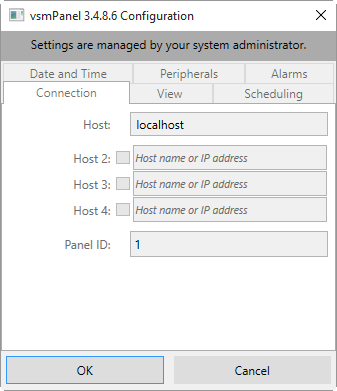

In this mode it is not possible to make any changes.
When there is no User configuration it will be created after opening the panel and closing it again or by selecting 'Cancel' or 'X'.
When the User configuration differs from the Global configuration it will be overwritten by the Global configuration when selecting 'OK'.
'Cancel' or 'X' closes the configuration mode window and either creates the initial User configuration or overwrites it if it is already available.
No Global Configuration is present and no admin rights
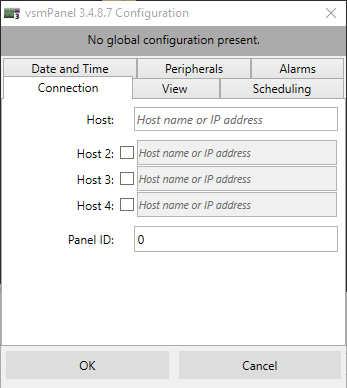
When no Global configuration is present the host entry field is empty and the Panel ID is set to '0'. Since there is no Global configuration you can change settings in the configuration window.
If there is also no User Configuration it will be created automatically when opening or closing the panel with 'Cancel' or 'X'.
'OK' will open the panel and save changes to the User Configuration. 'Cancel' or 'X' will close the configuration mode window and overwrite the User configuration when changes have been made.
Global Configuration is present with admin rights
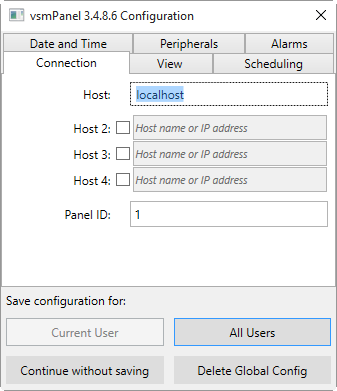
If a Global configuration is available the configuration mode window will import its settings from there. In this case the 'Current User' button is greyed out.
Selecting 'All Users' will write changes into the Global Configuration. Once selected a confirmation prompt will pop up.
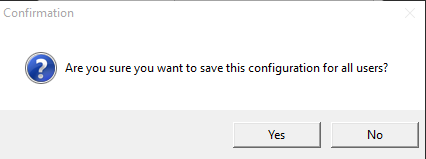
Selecting 'Yes' will open the vsmPanel window. When closing the window the User configuration gets overwritten by the Global Configuration.
'Continue without saving' overwrites the User Configuration as soon as the panel will be opened. The Global configuration remains untouched. This is also the case when closing the configuration mode window with 'X'. When opening vsmPanel again the configuration mode window will import its settings from the global configuration. Again, opening and closing the vsmPanel window will overwrite the User Configuration with the global configuration.
'Delete Global Config' deletes the Global configuration from C:\ProgramData\Lawo\vsmPanel. Once selected a confirmation window pops up.
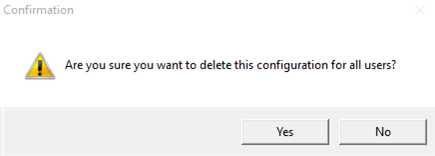
The 'Current User' button gets usable again after selecting 'Delete Global Config'.
When you close the vsmPanel window the User configuration gets overwritten by the Global configuration.
No Global configuration is present with admin rights

When no global configuration is present the 'Delete Global Config' button is greyed out as well as the 'All Users' button when the host entry is empty.
If there is no User configuration 'Current User' or 'Continue without saving' or 'X' will create a xml file. 'Current User' or 'Continue without saving' or 'X' will overwrite the user configuration when changes have been made.
'All Users' will create a global configuration and grey out the 'Current' user button.
vsmPanel Window

ID

It is possible to change the Panel ID when selecting the section ID on the top and bottom left corner.

Once selected the Panel Number window opens where an alternatively Panel Number can be entered and confirmed by OK. Once confirmed the panel will switch the new entered Panel ID.
Zoom
![]()
Using Zoom it is possible to zoom in and out of the virtual Panel. The range goes from 80 to 150%. You can zoom in or out by selecting the entry field with the left mouse button and moving the mouse from left to right or up and down. The value will in- or decrease in steps of 10%. Alternatively you can enter a value between 80 and 150.
Fit to Window
![]()
Using fit to window will adapt the size of the virtual panel to the size of the vsmPanel window as long as the vsmPanel window is smaller than the virtual panel. It will not enlarge the virtual panel. Once selected Fit to Window is highlighted blue.
Connect to…
This section displays the available Servers and their online status which serve as backup and contain the same configuration. These servers are in the same cluster. The checkmark indicates to which server the panel is connected.


It is possible to switch to another Server by selecting it from the list.
Redundancy state
![]()
The redundancy state is a red dot that will blink as soon as there is no redundancy guaranteed anymore.
1 Server | No redundancy state |
|---|---|
2 Server | Redundancy state will be active when one Server fails |
3 Server | Redundancy state will be active when two Server fail |
4 Server | Redundancy state will be active when three Server fail |